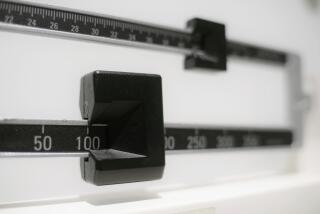Planning is key for weight loss
- Share via
To reach a healthier weight, you have to trim calories -- either by eating less, moving more or a combination of the two.
The trouble is, most people are pretty sloppy in calculating how many calories they eat. What’s more, the heavier you are, the more likely you are to be inaccurate: Up to 46% of people who are overweight or obese underestimate what they eat by about 300 to 400 calories a day.
It’s that kind of miscalculation that can thwart weight loss.
One solution is to let a computer do the counting. A personal digital assistant (PDA) makes it possible to record food eaten throughout the day. Scientists have theorized that these devices would make it easier to track food eaten and that “accuracy in counting calories would improve,” says Jean Harvey-Berino, chairwoman of nutrition and food science at the University of Vermont.
But when Harvey-Berino and her colleagues tested that theory in a recent six-month study of 61 overweight adults who also received nutrition counseling, they found that a PDA didn’t improve the accuracy of counting calories. Nor did participants achieve better weight loss, says Harvey-Berino, who published the results in this month’s Journal of the American Dietetics Assn.
So what does work? Planning and portion control, experts say.
In a University of Pittsburgh study, researcher Rena Wing gave participants pre-measured food to eat, similar to what some diet plans, including NutriSystem, Jenny Craig and Slim-Fast, do. The approach “worked better than counting your own calories,” Harvey-Berino notes.
That approach may be good for the short term, but few people are willing to permanently delegate their food choices to someone else -- or are able to afford prepared meals. In a follow-up study, the same researchers provided menus and grocery lists.
That strategy was just as effective in controlling calories and fostering weight loss as providing the meals themselves.
But planning meals that meet your calorie targets can be challenging. A strategy that can make it easier is to use one of the free, online Web tools.
In the evening, plan meals for the next day. Print the list and you’ve got a clear dietary game plan to follow. If the day doesn’t go as expected, you can easily note the differences in food on the plan. That allows you to stay on top of what you’re eating and makes it more likely that you’ll meet your calorie goals.
To test the ease of using these free online tools, I plugged a day’s worth of meals and snacks, adding up to 1,500 calories, into each site. Eating that number of calories would produce about a one-pound loss per week for an adult who normally consumes 2,000 calories a day. Find a copy of the menu at www.leanplateclub.com.) Here are the websites tested and how they stacked up for ease of planning meals:
* FitDay (www.fitday.com). This site generates lots of pie charts to examine what you’re eating and burning. There’s a nifty feature to customize your food so you can tweak some of the standard calorie counts to better represent what you’re eating. What I didn’t like: Type in a simple food -- oatmeal -- and you have to wade through five pages of listings for oatmeal bread, oatmeal cookies and more just to find that plain old oatmeal.
* Nutridiary (www.nutridiary.com). Short on time? This site offers a guest feature that lets you use it immediately without registering first. It’s a quick way to see how you like planning meals ahead of time. It also provides good, first-time user information. Another feature: You can turn off all ads on the site.
* NutritionData (www.nutritiondata.com). Like technical information? NutritionData not only records food, but also will guide you to better choices with various tools: a “caloric ratio pyramid,” “nutrient balance indicator” and “nutritional target map.” Or plug in your own recipes and NutritionData will calculate the calories and nutrients for you. To use this feature, however, you’ll need to spend some time recording each ingredient in your own personal online “pantry.”
* SparkPeople (www.sparkpeople.com). This site asks for a lot of information before you get started, but that allows you to consider both your food and fitness goals. It sets daily limits on calories, fat, carbohydrates, protein and water based on your goals. It also allows you to add up to 75 other nutrients to track, such as fiber, cholesterol, sodium and more, making it a good option for those who have special dietary or health needs.




